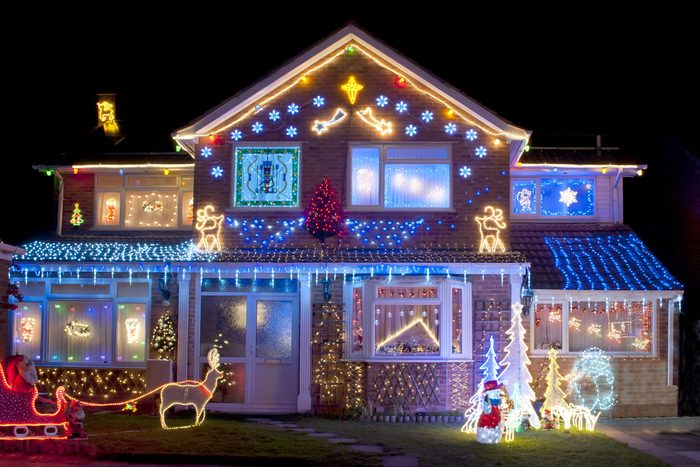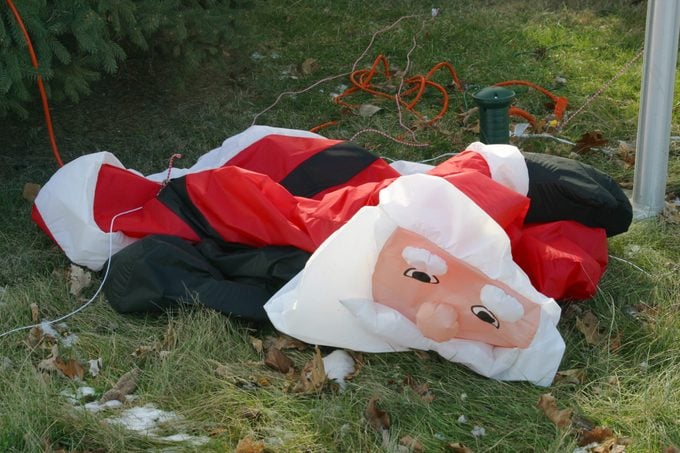When Should You Take Down Your Christmas Lights?

Christmas lights bring joy in December, but irritation by March. How long is too long? What's your cutoff date, and what do the experts say?
Fall brings decoration-heavy holidays. Jack-o’-lanterns and skeletons give way to corn stalks and hay bales. And after that last bite of pie is eaten on Thanksgiving? Out come the Christmas lights. (Although these days, waiting until Thanksgiving signals major restraint.)
Whether you toss a string of lights on a potted evergreen or deck out your house Clark Griswold-style, putting up Christmas lights gets us into the holiday spirit. Taking them down, though? Not as much of a high. Maybe that’s why some people leave them up until they (and possibly you) just can’t take it anymore.
I had a neighbor who left Christmas lights up year round, and I once neglected mine until February. (Though I did feel bad about that.) But what does an etiquette expert have to say on the subject? How long can you properly — and safely — leave them up?
On This Page
When To Take Down Christmas Lights
Though you’re free to leave them up as long as you want — barring a city ordinance — Diane Gottsman, an etiquette expert and founder of the Protocol School of Texas, suggests a more firm deadline.
“Lights can come down anytime after Christmas and preferably before Three Kings Day,” she says. That means January 6, the feast of the Epiphany in Christian tradition, which signifies the end of the Twelve Days of Christmas.
The National Fire Protection Association’s National Electric Code (NEC) has its own rule about holiday lights: You can keep them up for 90 days, max.
Why It’s Important To Take Down Christmas Lights
“People who leave their lights up for too long often irritate neighbors who want their neighborhood to look fresh and well-maintained,” Gottsman says. (Guilty. Hey, my neighbor’s sad puddles of flattened inflatables were still there in June!) And, Gottsman says, it detracts from your home’s curb appeal.
“Holiday lights are welcome during the season,” she says. “But when you wait too long to take them down, it appears as if you’ve overlooked an important part of the tradition.”
Let’s talk about the safety aspect, too. The NEC isn’t concerned about judgy neighbors so much as preventing fires. People hang Christmas lights in trees, use a bunch of extension cords and generally do things that aren’t up to code for regular permanent wiring.
What’s more, growing vegetation puts a strain on wiring and can wear down insulation. So take them down in a timely manner, keeping the NEC deadline in mind. Christmas lights aren’t designed for year-round use.
How To Take Down Lights
“There’s always someone who leaves them up too long,” Gottsman says. Don’t let that be you this year. Here are some ideas for removing and storing your Christmas lights, so you’ll be ready to go when next Thanksgiving (or Halloween, for you early birds) rolls around.
Be safe
Don’t just start ripping lights off the house and trees. You’ll break bulbs and stress the wiring, which can be a potential fire hazard. About 790 house fires per year start with holiday decorations, according to the National Fire Protection Association. Unplug all your Christmas lights before taking them down, and practice good ladder safety.
Test
When the excitement of next season rolls around, don’t let a string of dead Christmas lights ruin your mood. Test every light set and other electric decorations now before stashing them. Plug them in to see if they light, or use a Christmas light tester to find and repair common problems like half-illuminated strings.
Store neatly
When you’re certain your Christmas lights are in good working order, don’t just jam them in a box and call it a day. That’s a recipe for frustration next year. Wind them around a cardboard “spool,” or make a real spool with dowels or even 2x4s. Spool them backward, starting at the non-plug end, so it’s easy to unspool from the power source next year.
Label
Some people wing their lighting displays each year. Others, not so much.
If Santa’s sleigh needs a specific wattage or flashing pattern or whatever crazy thing you’re doing this season, label your lights so you know what’s what. Group displays together in containers, and label the outside of the bin.
Recycle
If you discover lights that don’t work and aren’t worth fixing, recycle them. Hardware stores often take them, as do some charities. Check your city and county websites to see your options. Even if your city doesn’t have a recycling program, they should provide disposal and recycling information.




